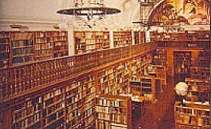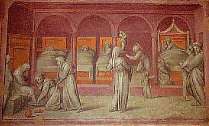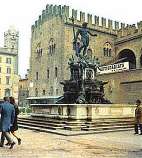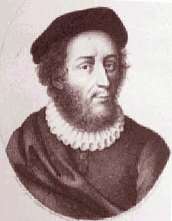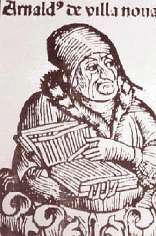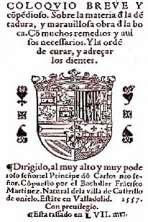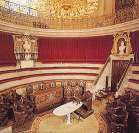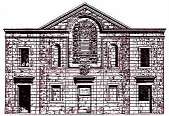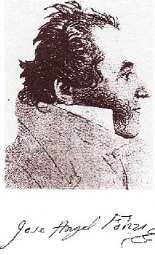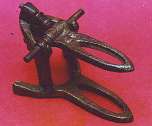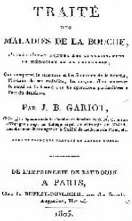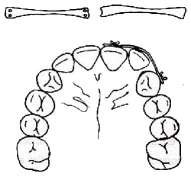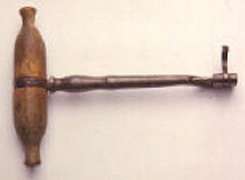Prof. Josep M. Ustrell
School of Dentistry
University of Barcelona
We are going to see the odontology as practiced in Southern Europe during the XVIII th century; and the influence that countries, such as France and Italy, had on ours. This influence has a background that goes back to the Middle Ages.
During the count’s period, monks, particularly the Benedictines, ensured the continuity of medicine. They made possible the attention of the sick people; and they did it in the frame of the commitment, on the one hand, between medical principles and religious aspects, and on the other hand, by not facing illness as a punishment or healing as a miracle. (The bottom right imagine shows the rector of Bernac, a town near Albi (Toulouse). He offers Saint Apolonia’s relic to prevent children’s dental problems.)
In this period of the Middle Ages some universities, such as Montpellier and Bologna, were outstanding because of their breakthrough in anatomy and surgery.
They still considered that the most frequent dental problem, the tooth decay, was caused by worms; and the immediate complication, pain, was treated with Mandragora Officinalis among other natural products.
The most important authors of this period range from the end of the XII th century to the XIV th century.
Roger of Salerno (in the XII th century), Rolando of Parma (in the XIII th century) and Teodorico of Cervia (in the XIV th century) were the first surgeons to achieve renown.
In their works, they are in favour of teeth extraction only as the last resort. They advise fumigation and cauterization instead. They also deal with jaw fractures and dislocations.
Among the most important surgeons we find Roger of Salerno who lived at the end of the XII th century. He was a menber of the Salerno School and in his work, the Practica Chirurgia, we can infer a clear jewish and arabic influence.
The same as in Rolando of Parma’s work who lived at the begining of the XIII th century.
It is not like so with the work of the XIV th century author Teodorico of Cervia. There is not such a big arabic influence in it. It is about, above all, jaw fractures and dislocations.
France also contributes with the work of three doctors who were at the University of Montpellier. In this case a doctor and two surgeons.
The English doctor Bernard Gordon wrote the treatise Lilium Medicinae that was wide spread. In the field of odontology, he describes internal and external causes.
Among the external he mentions oral hygiene, and among the internal the humors that go down from the brain to the teeth. He warns about the abuse of opium and advises to loosen teeth before the extraction.
In the XVI th century Henri of Mondeville wrote his Chirurgie where he describes, in Book 1, the tongue and the teeth.
But the best-known surgeon of this period is Guy of Chauliac. His work Chirurgia Vel Inventarium… was published for the first time in 1363 in Avignon. Three centuries later it was still a compulsory book for surgeons. It was republished until the XVIII th century.
The Inventarium… is divided into seven books. In the fourth one, the author writes about aphtas, in the fifth one he explains the symptoms of jaw fractures and the sixth one is devoted to non-ulcerous illness, such as the ones concerning the tongue and the teeth.
In Catalonia the works of Arnau of Vilanova, Simó Virgili and Micer Johan are very prominent.
The galenist Arnau of Vilanova is famous thanks to his scientific and medical works. They were republished until the end of the XIV th century. As all the medieval medicine, his works were based on the theories of the symbols, the humors, the attributes and the universal elements where, as well, it can be seen the theological interests.
He studied in Barcelona, Montpellier and Salerno, and he practiced dentistry in Barcelona, Sicily and Avignon.
In the Breviarium Practicae he explains that toothache sometimes comes from the brains vice because of the cold humors. These cold humors exude from the head, go down along the teeth nerves and produce a dull pain with a dazed head, swelling and paleness. When the humors are hot, the pain is sharp and stabbing and the face gets red.
Arnau of Vilanova was also worried about women’s beauty. In the Ornatu Mulierum and in the De Decoratione some prescriptions can be taken out to whiten teeth, to strengthen the gums and give them colour.
In the Regimen Sanitatis ad Regem Aragonum he advises to preserve teeth healthy to clean them twice per month with wine. In this wine, roots of thyme must be boiled.
To sum up, Arnau’s work deals with hygienic and dental problems in a hipocratic light.
In the XIV th century the odontologic job had a very little appreciation. They were itinerant and studies weren’t necessary. On the other hand, this is a time when surgery, barbershop and dentistry converge. The latter having an especial recognition.
When the Aragon crown was ruled by Pedro III el Ceremonioso (1319-1387), it appeared in surgery the Mestre Caxaler.
His professional activities were: cleaning teeth, soothing pain and teeth extractions. Other activities they could practice were the bleeding and the application of enemas, but because of the title they hold it seems that it was a « full-time » job.
When Martín el Humano died, the uses and prerogatives of the Trastamara dinasty caused the caxalers to lose their prestige and so ended a singular period in the history of odontology.
And from the XV th century we encounter prescription pads such as Micer Johan’s. It is probably a copy of the Tesoro de los Pobres (Poor’s treasure), a compilation which began in 1466 as the king Alfonso V el Magnánimo stipulated. (The bottom left image corresponds to a gargoyle in the Generalitat of Catalonia Palace from the XV th century.)
During the Renaissance science was favored by these great changes that allowed medicine to develop its scientific method.
Spanish medicine was aware of these changes but they only penetrated the highest rank of society. Quacks and hawkers continue facinating the lower classes.
Odontology also lived parallel moments with some differences. The pionner work of the graduate Francisco Martínez will be the exponent of this scientific level.
His work, Coloquio Breve y Compendioso… (1557) is written in a dialogue form. It contains all the odontological knowledge of the moment. It was a book of reference throughout the century.
In the XVII th century odontology wasn’t very fruiful. There were only the contributions of some authors, such as Alonso Muñoz and Diego Pérez de Bustos.
The work of the latter, Tratado Breve de Flobotomía contains some engravings. It was written like Martinez’s as a dialogue.
The XVIII th century saw the rebirth of odontology. This rebirth was the consequence, somehow, of the improvement of surgery in our country thanks to the foreign surgeons that found here the best conditions to work.
Odontology and surgery recovery go hand in hand. European influence is the most important motivation after decades of scientific isolation. This influence progressed thanks to the great number of professionals, especially French, that were working for the Borbon dinasty.
Two reasons may explain this phenomenon. On the one hand, during the Succession War, Felipe V army was formed mainly by french people and among them there were surgeons. On the other hand, the existence of a different labor market especially devoted to the new militar organization.
The genovese José Rotondo and the napolitan José Angel Fonzi are among the firsts we have any record . They both were dentists in the Royal household.
José Angel Fonzi was born in Osorga and died in Barcelona. He had several occupations until he saw the performance of an itinerant dentist. This encourage him to devote to odontology.
Fonzi managed to improve the application of porcelain teeth. He gave them a platinum post which weld to the base. This was different from Dubois de Chêmant partial and complete false teeth that were only one piece. It was also his the first odontological use of rubber. He used it to cover the alveolus face of the metalic bases to hide the flaws.
We also have record of two other dentists graduated in the Royal College of Surgery in Barcelona. They were Michael Filipo Adorno (1770) and Giovani Domenico Bonacorsi (1771).
Many french dentists, such as Pierre Gay, Ricard Le Preux, Blas Beaumont, Pierre Abadie and Tomas Clanet, also came to our country. All of them were dentists in the Royal household. Some of them contributed, as well, with written work.
Of the following we also know their birth place: Jean Baptiste Rouyer from Lorena, Jean Baptiste Gariot from Sante Machoul, Georges Simitier from Marsella and Guillaume Petit from Montpellier.
One of the most outstanding was Jean Baptiste Gariot. He practiced dentistry in Barcelona, Valencia and Madrid. He wrote a treatise about mouth illnesses. He also invented an articulator to simulate teeth position. The catalan, Luis Subirana did this later in the XIX th century.
We also have record of some dentists graduated in the Royal College of Surgery in Barcelona: Paul Maurice Darnés, in 1775 and in 1777 Benoît Descroix Niset stated as dentist and ophthalmologist.
In France, Pierre Fauchard was the soul of the french odontology of the century and he created school after him.
In Fauchard’s work Le Chirurgien Dentiste there is a deep and systematized exposition of the possibilities of dental art. Its influence spread out in other countries and gave a new impulse to odontology. This influence can also be seen in his contemporaries.
One of his followers, Etienne Bourdet contributed with garegeot key.
Some spanish authors were also influenced by Fauchard’s works. And their books were a reflection of Fauchard’s.
Francisco Antonio Peláez (1736-1805) in his Tratado de las Enfermedades de la Boca, translated the medical part. And Félix Pérez Arroyo (1755-1809) in his Tratado de las Operaciones que deben practicarse en la dentadura y Método para conservarla en buen estado, translated the surgical part.
Sumary
Four surgeons (3 Italian and 1 French) written work influenced decisively Middle Ages dentistry.
Montpellier University is the most influential in Catalonia.
During the transition period Francisco Martínez (16 th century) was source of inspiration for the homologous Diego Pérez (17 th century) and for the french Ricard Le Preux (18 th century). All use the dialog as a literary resource.
Italian comes to Spain to graduate at the Royal College of Surgery or to practice dentistry at the Spanish Royal House.
Fonzi contributes in the development of porcelain teeth and incipient use of rubber.
French came to Spain for the same reason as Italian did but, additionally, they left written documents.
Gariot’s contribution is the charnela articulator and Bourdet’s the garengeot key for teeth extraction.
Fauchard’s work will influence Spanish dentistry. Francisco Antonio Peláez on the medical side and Félix Pérez Arroyo on the surgical side.
France makes de deepest contribution to odontology during 18 th century.

